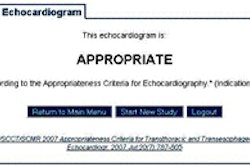In a new report to the U.S. Congress, the Medicare Payment Advisory Commission (MedPAC) suggests that the in-office exception to the Stark anti-self-referral law may not be achieving its intended goal, and, instead, may be contributing to unnecessary use of ancillary healthcare services such as medical imaging.
The June 15 report, titled "Aligning Incentives in Medicare," was commissioned to help Medicare move away from payment policies that encourage a higher volume of healthcare services and toward the federal government's goal of a reformed healthcare delivery system. The in-office exception to the Stark law comes under major scrutiny in the report, which expresses doubt about whether the exception is serving its intended purpose.
"These findings raise questions about one of the primary rationales for the [in-office] exception," according to the report.
Same-day services
Named after its author, Rep. Pete Stark (D-CA), the Ethics in Patient Referrals Act of 1989, more commonly known as the Stark law, prohibits physicians from referring patients to entities in which they have a financial interest, a practice known as physician self-referral. However, the law includes exceptions for four types of ancillary services: outpatient therapy, clinical lab tests, anatomic pathology tests, and diagnostic imaging.
The report notes that one of the main reasons for the in-office exception is for patients to receive ancillary services on the same day as their office visits. This is desirable, in theory, because it allows physicians to better supervise the quality of care, improves care coordination and efficiency, and, not least, enhances patient convenience.
To see whether the in-office exception was achieving its goal, MedPAC studied Medicare claims data from 2007 to 2008 to determine the volume of ancillary imaging services patients received at three time points: on the same day as an office visit, seven days after a visit, and 14 days after a visit. In theory, same-day services conform to the stated purpose of the in-office exception.
MedPAC found that on the same day as an office visit:
- Outpatient therapy is rarely provided.
- Fewer than half of advanced imaging, ultrasound, clinical laboratory, and pathology services are performed.
- About half of standard imaging studies, such as x-rays, are performed.
It would seem that physicians' ability to perform imaging in their own office makes for more -- and perhaps inappropriate -- imaging use, MedPAC wrote.
"Several studies -- including recent research conducted by [MedPAC] -- have found that physicians who furnish imaging services in their offices refer patients for more imaging than other physicians," the report stated. "Researchers also found that physicians with a financial interest in physical therapy initiated therapy for patients with musculoskeletal injuries more frequently than other physicians."
Imaging analysis
In its analysis of imaging studies, MedPAC found that advanced imaging exams such as MR, CT, and nuclear medicine were less likely to be provided on the same day as ultrasound or standard imaging (chest, musculoskeletal, other x-rays): Only 10% of these advanced services were performed on the same day as a related office visit.
Meanwhile, 33% of advanced imaging studies were performed within seven days after a visit, and 41% were conducted within 14 days of a visit. About 25% of ultrasound studies were done on the same day as an office visit, 40% were performed within seven days, and 46% within 14 days. As for standard imaging, just over half of procedures were performed the same day as an office visit; within 14 days, that percentage was 59%.
The lower rate of advanced imaging procedures may be due to the need to schedule them in advance because of fasting and contrast agent concerns, MedPAC wrote.
Rapid growth in volume
In a 2008 proposed rule issued by the U.S. Centers for Medicare and Medicaid Services (CMS), the agency asked whether certain services should continue to qualify for the in-office exception. In the new report, MedPAC notes rapid growth of services covered by the exception, and cites evidence that these services are sometimes provided inappropriately.
The volume of services covered by the in-office exception grew rapidly between 2003 and 2008. Diagnostic imaging services increased by 7.2% per beneficiary, per year, during this time frame, and the volume of radiation therapy services increased by 7.8% per beneficiary, per year. But all physician services grew only 4.6% per year.
The growth rate in the volume of all imaging services decreased to 3.3% per beneficiary between 2007 and 2008, but some types of imaging still grew quickly: The volume of echocardiography and CT scans of parts of the body other than the head increased by 4.6%, and CT scans of the head rose by 4.4%.
Inappropriate use of imaging isn't only occurring within physicians' offices, MedPAC warned -- it also happens in hospitals. As such, solutions to the problem should take multiple settings into account.
The commission suggested three ways to address concerns about the growth of ancillary services:
- Limit the types of services or physician groups covered by the in-office exception.
- Develop payment tools to mitigate incentives to increase volume.
- Adopt a targeted prior authorization program for advanced diagnostic imaging services.
"The preferred approach to address self-referral is to develop payment systems that reward providers for constraining volume growth while improving the quality of care," MedPAC wrote. "Because it will take several years to establish new payment models and delivery systems, policymakers may wish to consider interim approaches to address concerns raised by the growth of ancillary services in physicians' offices."
The House Committee on Energy and Commerce's subcommittee on health intends to hold a hearing on June 23 to examine the findings and recommendations contained in the MedPAC report.
Growing concern
The movement to limit the in-office exception has been gaining momentum, according to W. Kenneth Davis Jr., an attorney at the law firm Katten Muchin Rosenman in Chicago.
"A crescendo has been growing in the past few years to limit the in-office exception," he said. "[MedPAC's report] is newsworthy in that the group is specifically setting forth a range of alternatives for narrowing the effect of the -- at least perceived -- abuses of this exception to the Stark law."
The report confirms that the in-office exception is a problem that needs to be addressed, according to Tim Trysla, executive director of the Access to Medical Imaging Coalition (AMIC) in Washington, DC.
"We can see from MedPAC's continued analysis that this issue is going to be something policymakers and Congress will continue to scrutinize," Trysla told AuntMinnie.com. "It also shows how important it is to develop effective policies that address the issue. Industry needs to invest in getting data that give the most complete picture of how imaging is used and how its use improves patient outcomes."
The report indicates that in-office ancillary services aren't necessarily performed on the same day as the office visit. But does that make the services inappropriate? Trysla asked.
"Yes, the basic finding is true, but what does it say about quality of care?" he said. "It's unclear what any of MedPAC's suggested reforms will do for patient care."
By Kate Madden Yee
AuntMinnie.com staff writer
June 23, 2010
Related Reading
MedPAC recommends modest physician hike, March 5, 2010
Senate delays Medicare payment cuts until April, March 3, 2010
Senate fails to avert 21% Medicare cut, February 26, 2010
Obama signs SGR fix legislation, December 23, 2009
Flawed MedPAC survey drives debate on imaging payment cuts, August 11, 2009
Copyright © 2010 AuntMinnie.com




















